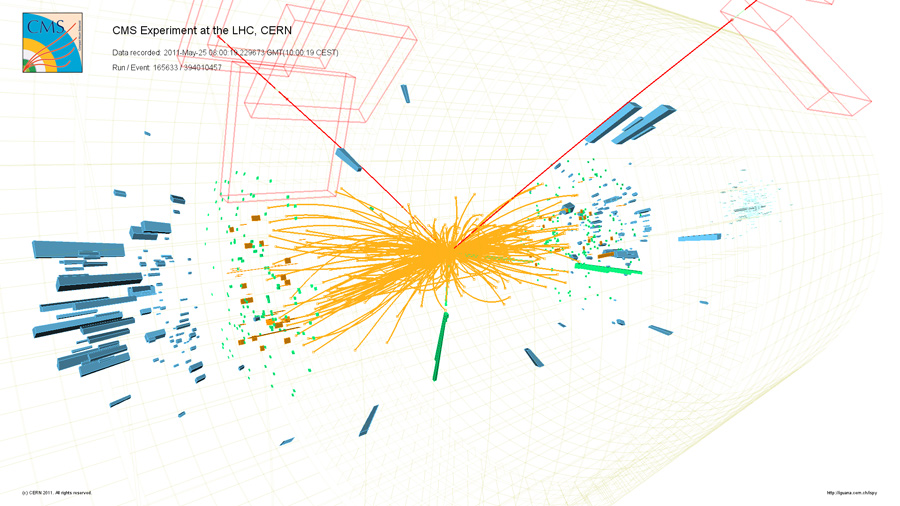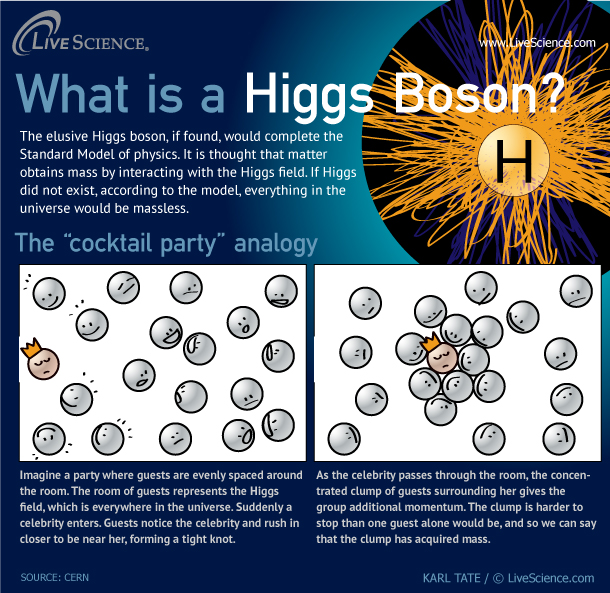Atom Smasher's Higgs Particle Findings: Physicists React

Scientists at the world's largest particle accelerator announced today (Dec. 13) that they'd narrowed down the possibilities for the existence of the elusive Higgs boson particle. This particle, long theorized but not yet detected, is thought to explain why particles have mass.
The data so far from the Large Hadron Collider (LHC) indicate that if it exists at all, the Higgs must weigh between 115 and 130 times the mass of a proton (a unit denoted by gigaelectronvolts, or GeV). Two experiments at LHC, called ATLAS and CMS, also show hints that they've seen a particle weighing about 124 or 125 GeV that could be the Higgs boson.
Though it's too soon for physicists to declare a definite discovery of the Higgs, experts said the findings so far represent an important step forward. Here's what some leading physicists have to say about today's announcement:
"This is not the end, but the beginning. The Higgs was just the last missing piece of the Standard Model of particles. But that theory is ugly; it is a theory only a mother can love. The real breakthrough is when the LHC discovers dark matter or strings. That would be spectacular. So there is a whole new universe beyond the Higgs." [Gallery: Search for the Higgs Boson]
—Michio Kaku, City College of New York theoretical physicist, told LiveScience
"Both experiments showed a very impressive turnaround in processing the data and very good understanding of their detectors. It is unprecedented to have full data samples from such complex experiments to be analyzed in a fairly sophisticated way in just one month since the end of the proton-proton run.
—Greg Landsberg, Brown University physicist, CMS physics coordinator at the LHC, told LiveScience
Get the world’s most fascinating discoveries delivered straight to your inbox.
"ATLAS data, just like CMS ones contain interesting excesses. Whether what we both see is a real signal or just a funny game [that] statistics often play with us, remains to be seen.
"This looks to me like a lot more than 'intriguing hints': it's about what you would expect if a Higgs was there at 125 GeV, highly unlikely to see if there is no Higgs there."
— Peter Woit, Columbia University mathematician, from his blog "Not Even Wrong"
"Essentials: what we're seeing is pretty consistent with the existence of a Higgs boson around 123-126 GeV. The data aren't nearly conclusive enough to say that it's definitely there. But the LHC is purring along, and a year from now we'll know a lot more.
"It's like rushing to the tree on Christmas morning, ripping open a giant box, and finding a small note that says 'Santa is on his way! Hang in there!' The LHC is real and Santa is not, but you know what I mean."
—Sean Carroll, California Institute of Technology physicist, from his blog "Cosmic Variance," hosted by Discover Magazine
"All in all, it's a definite maybe. Putting the results together in the way only a frequentist can the result is a 2.4 sigma detection. In other words, nothing any serious scientist would call convincing."
—Pete Coles, Cardiff University theoretical astrophysicist, from his blog "In The Dark"
"Two independent (and highly competitive) research teams, involving thousands of scientists, using each of these detectors have seen moderately convincing evidence that the elusive Higgs particle has been created in some of the proton–proton collisions.
"This is a challenging experiment as the detectors can't see the Higgs particle directly — it is a short-lived particle that quickly falls apart (decays) — but, rather, they infer its presence by seeing its decay products."
—Brian Greene, Columbia University physicist, on the "World Science Festival" blog
"The proof will come in the next year. The spectacularly successful LHC accelerator (which the Europeans built when the U.S. killed the superconducting super collider in Texas) will produce 4 times more Higgs particles in the next year. The significance of the hints reported today could turn into proof beyond a doubt come next October.
"What does this mean? The biggest mystery physicists have been trying to understand for the last half century is the 'mystery of mass.' The hydrogen atom is the paradigm of nature, with a + proton surrounded by a quantum cloud of a -electron. Yet the proton is 2,000 times heavier than the electron. No one has the slightest idea why. Peter Higgs hypothesizes that the vacuum is filled with an as yet undiscovered particle, the Higgs particle, which acts as molasses in slowing down whatever passes through it. A heavier particle is nothing more than one that has more interactions with the Higgs particle as it passes through the vacuum.
—Lawrence Sulak, Boston University physicist, member of CMS collaboration, told LiveScience
"Will we ever conclusively find the Higgs?
"It seems that the year 2012 will reveal it to us. In April 2012, the collider will start up again, apparently at a higher energy and greater collision frequency.
"We can expect that the summer of 2012 will be a summer of tidings."
— Eilam Gross, Weizmann Institute physicist, ATLAS Higgs physics group convener, on the "Weizmann Wave" blog at ScienceBlogs
Follow LiveScience for the latest in science news and discoveries on Twitter @livescience and on Facebook.





